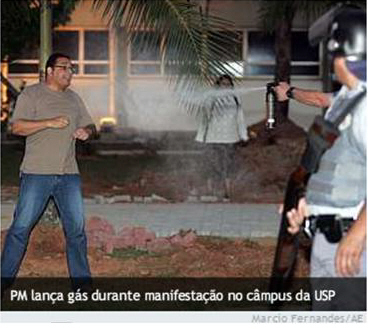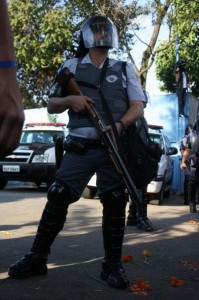Quando chegamos na altura do gramado, havia uma multidão de centenas de pessoas, a maioria estudantes correndo e a tropa de choque avançando e lançando bombas de concusão (falsamente chamadas de “efeito moral” porque soltam estilhaços e machucam bastante) e de gás lacrimogêneo. A multidão subiu correndo até o prédio da História/ Geografia, onde a assembléia havia sido interrompida e começou a chover bombas no estacionamento e entrada do prédio (mais ou menos em frente à lanchonete e entrada das rampas). Sentimos um cheiro forte de gás lacrimogêneo e dezenas de nossos colegas começaram a passar mal devido aos efeitos do gás – lembro da professora Graziela, do professor Thomás, do professor Alessandro Soares, do professor Cogiolla, do professor Jorge Machado e da professora Lizete todos com os olhos inchados e vermelhos e tontos pelo efeito do gás. A multidão de cerca de 400 ou 500 pessoas ficou acuada neste edifício cercada pela polícia e 4 helicópteros. O clima era de pânico. Durante cerca de uma hora, pelo menos, se ouviu a explosão de bombas e o cheiro de gás invadia o prédio.
The above lines are an excerpt from a testimonial by Prof. Dr. Pablo Ortellado, published on the Letras em Greve [Languages on Strike, pt] blog, about a peaceful demonstration in the University of São Paulo (USP), Brazil's largest university, which ended in a violent confrontation with Police on Tuesday, June 9th. Many demonstrators were hurt, some jailed. Another professor, Marcos Ferreira Santos [pt], posted the picture below and his own account:
Esta é a maneira de “dialogar” da PM e da Reitoria.
Na tentativa de conversar com o comandante da unidade de choque, o despreparo, má formação e autoritarismo de PMs na ação, levaram a me agredir com gás de pimenta, de maneira gratuita, violenta e sem nenhuma necessidade. Atingiram também minha esposa, Solange Francisco, funcionária. Ao falar com o comandante, Ten Cel Longo, me desrespeitou e ao me identificar como professor da USP, ameaçou me “prender”, com a mesma prepotência que somente havia visto com o Cel. Erasmo Dias, na invasão da PUC em 1977, quando eu era ainda estudante secundarista. O comando da PM no local também é despreparado. Depois com os professores Lisete Arelaro, Chico Miraglia e outros, tentamos novamente conversar para evitar o confronto, mas a resposta foi com bombas de gás lacrimogênio.
O mesmo despreparo, má formação e autoritarismo da Reitora Suely Vilela, demonstrando sua incompetência em gerir conflitos na USP.
During an attempt to talk with the commander of the riot police, the unpreparedness, poor training and authoritarianism led the police officers to attack me with pepper gas, for nothing, in a violent and needless fashion. They also hit my wife, Solange Francisco, an employee. When I was speaking with the commander, Col. Longo assaulted me and when I identified myself as a professor at USP, I was threatened with “arrest” with the same arrogance that I had only seen in Col. Erasmus’ days during the invasion of the PUC [university] in 1977, when I was still a high school student. The commanders of the PM were too unprepared. Then with the teachers Lisete Arelaro, Chico Miraglia and others, we tried to talk again to avoid confrontation, but their response was to fire tear gas.
The same unpreparedness, poor training and authoritarianism of dean Suely Vilela was shown through her incompetence in managing [these] conflicts at the USP.
The video below, edited by an independent group of students, shows the peaceful beginning and ugly end of Tuesday 9th of June:
Pablo Ortellado [pt] explains the background of the situation in a letter signed by a group of professors seeking the support of the international scientific and academic community:
Conflicts started after a one month strike of university workers whose employment status is being disputed due to a legal controversy over university autonomy to hire its workers without approval of state representatives. Over one thousand workers might loose their jobs. Workers started a strike on May 5 demanding the preservation of their jobs and other labor demands. On May 27, workers started to block the entrance of four university buildings because, according to them, university management was threatening workers who were using their legal right to strike. On June 1, administration called the military police to intervene. On June 4 professors joined the strike protesting police occupation of campus. on June 5, professors had a two hours meeting with management asking for a non-military solution to the labor conflict. However, common sense did not prevail and military police attacked a peaceful demonstration of students and workers yesterday (June 9). 120 professors were discussing the crisis when the meeting was interrupted by news of a police attack. A few minutes later teargas and concussion bombs exploded inside the building. Several of our colleagues and students were hurt. The academic community is shocked.
On that Tuesday, the riot police came into confrontation with students, staff and teachers during a demonstration whose goal was exactly the removal of the police currently on the campus. The event has been well documented and many accounts can be found online. Roque [pt], a USP student, records his personal account and recalls the history of repression that the USP used often to see:
Segundo informações do Sindicato dos Trabalhadores da USP, o Sintusp, a última vez em que houve uma intervenção policial no campus da Cidade Universitária foi em 1979, há exatamente 30 anos atrás, nos tenebrosos tempos da ditadura militar, e contando com um efetivo de 10 ou 15 policiais desarmados.
Os erros, excessos ou táticas reprováveis do movimento universitário são uma coisa. O envio do batalhão de choque da Polícia Militar, o espancamento de estudantes e o uso dos cassetetes e das bombas de gás lacrimogêneo são crimes, são acontecimentos de dimensão completamente distinta. São responsabilidade direta da Polícia subordinada ao governador. Ele tem obrigação de responder por ela. São atrocidades perpetradas pelo poder público.
According to the police version of events, the confrontation began when a group of five or six students provoked police officials on motorbikes. Pablo Pamplona [pt] responds sarcastically to the commander of the operation Col. Cláudio Longo's claims during a radio interview:
Segundo o coronel, estudantes PEGARAM os policiais de suas motocicletas (que os pobres coitados não tiveram tempo de fugir ou se proteger, afinal todo seu equipamento não era páreo para os livro e mochilas mortais dos estudantes terroristas) e os fizeram de REFÉNS.
Tá.
Esse mesmo senhor coronel, durante a mesma entrevista, discute com uma garota que lhe aparece aos gritos argumentando algo sobre os absurdos cometidos pela PM. Ele ameaça prendê-la. Ela quer saber a razão. Desacato à autoridade, ele diz.
O repórter finaliza falando que ainda há tensão no local, com “estudantes que agridem policiais e policiais queeee… retiram estudantes”.
Onde quero chegar: está claro que as razões apresentadas pelos representantes da polícia são falsas. Não preciso explicar isso. As grandes mídias (ou seja, aquelas nas quais você não consegue expor a sua voz) dão sempre atenção especial às versões dos policiais. Tanto que na manifestação, os repórteres seguiram atrás do próprio batalhão da polícia, como a segunda fila de combate em um campo de guerra. Eles não querem as versões dos manifestantes, não lhes interessa. E essa mídia é a maior formadora de opinião da população. Façamos as contas.
OK.
This very same colonel, during the same interview, argues with a girl who shouts something about the absurd action of the police at him. He threatens her with arrest. She wants to know the reason. “Contempt of authority”, he says.
The reporter finishes off by saying that there is still tension there, with “students who hitting police and police … just dispersing students.”
My point: it is clear that the reasons given by the representatives of the police are false. I don't need to explain it. Mainstream media (i.e., those where you can not have your say) always give special attention to the police's side of the story. So much so that in the event, the reporters followed the riot police closely, like the secondline of troops in a war zone. They do not want the protesters’ versions of events, these do not interest them. And the media is the largest opinion maker for the population. Let's do the math.
Many agree with the point that the media is a partner with the government and the dean, thus accusing the protesters of belonging to a minority group of dissidants. Watching the events unfold on TV and live blogging them, Raphael Garcia [pt] makes an analysis of the press coverage, which according to him backed the police 100%:
1. Confronto entre Polícia e estudantes: Que confronto? Os estudantes protestavam pacificamente e foram atacados e em momento algum reagiram!
2. Provocação dos estudantes: Que provocação? O próprio repórter da rede afirmou que estavam distribuindo flores e haviam bloqueado uma rua! Bloquear uma rua em um protesto legítimo é suficiente para apanhar da PM?
E para fechar ainda falam “vejam como eram poucos policiais contra centenas de estudantes!” Só esqueceram de avisar que os estudantes estavam “armados” com rosas e a polícia com armas e balas!
Simplesmente um absurdo esta imprensa marrom, vendida, golpista!
2. Student provocation: What provocation? The TV's own reporter said they were distributing flowers and had blocked a street! Is blocking a street in protest a legitimate enough reason to get beaten by the police?
And to finish off they say: “see how few police against hundreds of students!”. They only forgot to explain that students were “armed” with roses and police with guns and bullets!
This media is simply absurd this dirty, sold, coup media!
Vinicius Justo [pt] says it is time to react and calls for action:
Se enganam aqueles que dizem que foi algo “justo”. Não pode ser justo uma força da polícia perseguir pessoas por 500 metros adentro da universidade. Não pode ser justo todos os policiais presentes estarem sem a devida identificação. Não pode ser justo o comandante da polícia dizer que interviu porque policiais “tinham sido feito reféns”. Com quem este homem está brincando? É assim que ele pretende se sair da acusação de força desproporcional? É assim que pedem para que confiemos na polícia?
Não é mais possível permanecer neutro, como eu disse acima. É preciso mostrar que não se pode tratar deste modo pessoas que protestam pacificamente contra um governo que impõe decisões, abstém-se do diálogo e pretende garantir o monopólio da razão. Havia os manifestantes que buscavam confronto direto com a polícia? Claro que havia. Estes são uma minoria. E não devem servir de base para fazer centenas de pessoas de bem passarem momentos de medo. Os vídeos estão na internet.
It is no longer possible to remain neutral, as I said above. We must show that they can not treat people who were peacefully protesting against a government that imposes decisions this way, that refuses to engage in dialogue and wishes to ensure the monopoly of reason. Were there demonstrators who sought direct confrontation with the police? Of course there were. These were in a minority. And it should not be the basis for making hundreds of good people go through moments of fear. The videos are on the Internet.
It is clear from the above blog post that not everyone in the USP community thinks the police intervention was wrong. Rafael Sola [pt] believes it is high time that the stance of some of the strikers was condemned, for example the invasion of the university buildings which started it all:
Quem acompanha de perto vê barricadas, cerceamento da liberdade, patrulhamento ideológico que chega até o limite da agressão física e de ameaças de sequestro. É preciso ir bem perto para ver como uma parte podre desse movimento grevista age de forma mafiosa e criminosa. Eu tenho amigos que sofreram ameaças de morte por protestarem contra os piquetes. Uma garota foi agredida na História por querer passar pelas barricadas e usar as salas de aula.
Catia P. [pt] tells of abuse by students who support the strike against those who want to attend classes. Some students from her translation class have issued the following manifesto:
Ninguém queria ver esse tipo de coisa dentro do campus. O recurso à ilegalidade por parte desse pessoal é de longa data: fechamento de portões, barricadas, violência e destruição do patrimônio público, invasões de prédios, são coisas que já fazem parte do cotidiano da USP já faz muito tempo. A ação pela recuperação da legalidade foi muito protelada, por medo de que a sociedade interpretasse mal imagino.
Nós sabemos que ao optar por fazer a prova estávamos, inevitavelmente, nos posicionando contra esta greve, mas não tínhamos sido avisados que a mobilização em favor de uma determinada ideologia é compulsória. Preferimos acreditar na autonomia da escolha do indivíduo. Nós lamentamos a truculência da polícia com os estudantes e nos posicionamos, também, contra isso. Porém, não admitimos que o nosso direito de escolha seja desrespeitado. Quando se tira o direito de escolha de alguém, tira-se sua alma. E não aceitamos que ninguém, nem mesmo os estudantes da Universidade de São Paulo, faça isso conosco.
We knew that by choosing to sit the exam we were, inevitably, positioning ourselves against the strike, but we had not been told that mobilization in favor of a particular ideology was compulsory. We prefer to believe in the autonomy of the individual's choice. We regret the truculence of the police against students and we also stand against it. But we do not accept that our right of choice is violated. When you take away someone's right to choose, you take their soul. And we do not accept that anybody, not even students of the University of São Paulo, do this to us.
On the other hand, Mariana [pt], who also disagrees with some of the student and strikers’ behavior, says that even though we should always advocate for people's right to fight for whatever they believe is fair and important – without being assaulted:
Mas apoiar tal ato ditadorial? Achar que vale tudo para preservar a “ordem”? Que é válido utilizar sprays de pimenta e bombas de efeito moral como instrumentos políticos?
É cuspir em cima de toda forma de liberdade que existe – ou que deveria existir. Não é “apenas” um crime, não é só porque faz todos aqueles que um dia já lutaram e/ou morreram pelo direito de se manifestar se revirarem nos caixões – ou cemitérios clandestinos.
É você, ser humano (?), achar que tudo bem um outro ser humano APANHAR e ser PERSEGUIDO porque ele defende algo com o qual você não concorda e de alguma forma fez com que você se sentisse prejudicado. APANHAR e ser PERSEGUIDO. Daí pra ser assassinado/torturado porque discorda é um passo. Pequeno, eu diria.
Que mundo é esse, gente? Que tipo de pessoas são essas?
It is like spitting on the top of every form of freedom that exists – or should exist. It is not “just” a crime, it is not only because it makes those who one day fought and/or died for the right of free expression turn in their graves – or clandestine cemeteries.
It is you, human being (?) who thinks it is okay for another human to be BEATEN and PERSECUTED because they advocate something that you do not agree with and that in some way makes you feel undermined. BEATEN and PERSECUTED. From there for them to be murdered/tortured because they disagree is just one step. A small one, I would say.
What world is this, people? What kind of people are these?
Students, staff and professors have been meeting in general assemblies to discuss further actions and other mass demonstrations, and as of now the strike continues. A few other demonstrations both, pro and against the strike, also ended in violence last week. The University of São Paulo is one of the largest institutions of higher education in Latin America, offering 600 courses to 75,000 students.













5 comments
Recentemente também publiquei um artigo no qual trazia também meu repúdio às atividades da PM no campus da USP. O governo não está preparado para dialogar com os moviemtos socias e leva a crer que tudo se resume em caso de polícia.
O ruim é que muitos ainda defendem essa postura de agressividade contra aqueles que se manifestam para garantir direitos legítimos.
Valeu
Excelent description of the invasion, well done!
We must spread this link through the world so everybody knows the real caracther of the brazilian police ond “our” governor!
O problema da USP são seus alunos.
Em sua maioria playboys e patricinhas, rebeldes sem causa, que utilizam o campus apenas para fumar maconha entre outras drogas, tirando assim a vaga de pessoas que querem realmente estudar.
Porque será que este tipo de comentário não me surpreende?
Quem o escreveu provavelmente é algum riquinho com sua BMW, que participou do flash mob e depois foi pra balada beber champanhe….
Tem maconheiro e gnete imbecil na USP? Claro, tem na PUC e em qualquer lugar, que argumentaçãozinha besta!